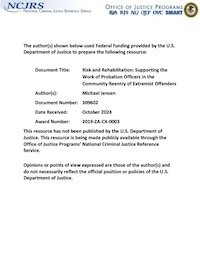By Michael Jensen, Sean Doody, and Elena Akers
To date, very little research has examined the specific challenges that individuals with ties to extremism face when reintegrating into their communities after arrest or incarceration. This has produced significant gaps in the scholarship on extremism, including a lack of data on terrorist recidivism from which to devise effective post-release supervision and support strategies. The implications of this knowledge gap extend beyond the halls of academia to matters of national security. Indeed, the United States is currently seeing an unprecedented surge in the number of individuals being released from custody due to their involvement in extremism. Without a robust research literature dedicated to this population, probation officers and service providers are without the scientific knowledge they need to help formerly incarcerated individuals achieve reintegration success. This project sought to address these challenges by focusing on three primary research objectives: 1. Build on existing NIJ-funded research to provide criminal justice professionals empirical data and rigorous analysis on the characteristics of U.S. extremists, their risks for recidivism, and their needs for reintegration success. 2. Gather evidence from in-depth interviews of pretrial services and probation officers, service providers, and system-involved individuals to understand the keys to successful reintegration. 3. Identify the training and education needs of pretrial services and probation officers to help them more effectively support the cases of formerly incarcerated individuals with links to extremism. Our mixed methods approach leveraged: (1) an extension to the Profiles of Individual Radicalization in the United States (PIRUS) dataset designed to estimate instances of both ideological and non-ideological recidivism amongst system-involved individuals with ties to extremism; (2) interviews with pretrial services and probation officers, service providers, and system-involved individuals to understand the needs and challenges this population faces during disengagement and reintegration; and (3) a survey of probation officers to identify the training and education they need to better support their releasees. We summarize our results below. Recidivism • We analyzed more than 1,800 cases of individuals who spent time incarcerated or on probation for committing extremist crimes from 1990-2022 and found an overall recidivism rate of 18.1%. • This rate is significantly higher than previous estimates, but lower than most estimates of recidivism among individuals who commit more typical crimes. • Recidivism rates were more than twice as high for the individuals in our data who were prosecuted by state or local authorities (26.4%) compared to those who were prosecuted in federal courts (13.1%). • Among individuals who recidivated, 59.2% committed new extremist crimes, 27.9% committed non-ideologically motivated crimes, and 12.9% committed both. • Our detection of a higher overall recidivism rate than previous estimates is due to the inclusion of individuals linked to domestic terrorist groups and movements in our analysis. • We find an exceptionally low rate of recidivism among individuals who committed crimes linked to their support of, or involvement in, international jihadism (7.7%), but a notably higher (19.8%) recidivism rate among individuals involved in domestic extremism. • Individuals motivated by their opposition to abortion reoffended at the highest rate (44.2%) in our data, followed by individuals motivated by environmental and animal rights concerns (27.3%). White supremacists and those with anti-government beliefs—the largest subsamples within our data—had recidivism rates of 18.9% and 16.1%, respectively. • The most important risk factor associated with recidivism is the presence of a criminal record prior to an individual radicalizing to their first extremist offense. For instance, individuals with a pre-radicalization history of violent crime were more than two times as likely to recidivate than individuals without a criminal record prior to radicalization (31.3% vs. 14.6%). • Co-offending, extremist group membership, a family history of extremism, and past trauma are associated with committing new ideologically motivated crimes. • Protective factors like being married, older, or having children did not significantly reduce the likelihood of recidivism in our data. Disengagement from Extremism • Past incarceration is a significant obstacle to disengagement from extremism and tends to co-occur with related exit barriers, such as low social mobility, low educational attainment, unstable work histories, substance use disorder, and mental illness. • The presence of a family member or romantic partner involved in extremism can be a barrier to disengagement as well. When present, this obstacle tends to co-occur with identity-related barriers, like social prestige and financial dependency on an extremist group or movement. • Individuals who spent time in prison, but who did not have family members or romantic partners with ties to extremism, were more likely to disengage when they accessed support services like mental health counseling and substance use treatment and were able to find stable employment. • Individuals who had extremist family members or romantic partners, but who did not experience confinement, disengaged when they became disillusioned with their ideology and severed personal relationships with extremists. • When individuals had both family histories of extremism and periods of incarceration, they were significantly less likely to disengage from extremism. These subjects faced a complex set of psychological, emotional, economic, and social barriers to disengagement that were challenging to overcome. Challenges to Successful Reintegration • System-involved individuals face difficult obstacles to securing basic needs, like housing, employment, and financial security, due to their criminal records and the social stigma associated with their involvement in extremism. • Severing anti-social relationships is an important part of successful reintegration, but it can be socially isolating, emotionally taxing, and traumatizing for system-involved individuals. Moreover, system-involved individuals often find it hard to establish new pro-social relationships upon release. • Mental health concerns and trauma are common experiences among system-involved individuals, as is difficulty accessing needed care. • Substance use, while not unique to extremism, can be a challenge among system-involved individuals after their release from custody. While some individuals may develop substance use disorders prior to entering prison, others describe turning to substances upon release as a form of self-medication and emotional coping. • Stigma is a constant challenge facing system-involved individuals with links to extremism. Beyond undermining individuals’ ability to find gainful employment and housing, social stigma also causes psychological distress due to public skepticism about the individuals’ ability to genuinely disengage from extremism. Case Management, Monitoring and Support Services for Successful Reintegration • Currently, there is no systematic process for identifying and triaging cases of extremism among the federally incarcerated population. Some probation officers reported the use of inconsistent heuristics and strategies to identify potential cases. Other officers reported that their districts do not flag cases with a nexus to extremism. • Probation officers do not always have well-established relationships with other law enforcement agencies, such as the FBI, that may be monitoring the individuals under their care. This can lead to a lack of information sharing and an inability for officers to adequately assess risk. (CONTINUED)
College Park, MD: National Consortium for the Study of Terrorism and Responses to Terrorism (START), University of Maryland 2024. 111p.





















